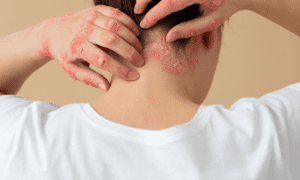Seborrheic dermatitis and eczema are common skin conditions that can cause discomfort and irritation. Although they have some similarities, they are distinct conditions with unique characteristics. This article aims to explain the differences between seborrheic dermatitis and eczema, including their causes, symptoms, and treatment options. Skin conditions can be troublesome, affecting one’s confidence and causing discomfort. Understanding the differences between seborrheic dermatitis vs. eczema is important to seek appropriate treatment.
Regularly washing hair with a cradle cap shampoo can help reduce scales and symptoms of seborrheic dermatitis. When dealing with eczema, following a proper treatment plan is important. Consider using eczema creams to soothe the skin and reduce irritation. These creams are designed to provide relief and hydration to affected areas.
Let’s explore each condition in more detail.
Seborrheic Dermatitis
Seborrheic dermatitis, commonly known as cradle cap, is a chronic inflammatory skin condition that primarily affects the sebaceous gland-rich areas of the body, such as the scalp, face, and upper chest. It is characterized by red, itchy, and flaky skin.
Causes
The exact cause of seborrheic dermatitis is unknown. However, several factors can contribute to its development, including Sebaceous glands causing overproduction of sebum, fungal colonization of the skin, elevated fatty acids, and an overgrowth of Malassezia yeast.
Symptoms
The symptoms of seborrheic dermatitis can vary from mild to severe and may include redness, itching, flaking, and greasy or oily patches of skin. Commonly affected areas include the scalp, eyebrows, sides of the nose, and behind the ears.
Eczema
Eczema, also known as atopic dermatitis, is a chronic inflammatory skin condition that can occur in people of all ages. It is characterized by dry, itchy, and inflamed skin.
Causes
The exact cause of eczema is not fully understood, but it is believed to involve a combination of factors like genetics, allergens, stress and worry, and bacterial infection. Triggers such as irritants, allergens, and certain foods can worsen the symptoms.
Symptoms
The symptoms of eczema include dry and sensitive skin, itching, redness, inflammation, and the formation of blisters or crusts. The affected areas can vary depending on the individual’s age, with babies commonly experiencing it on their face, scalp, and limbs.
Differences Between Seborrheic Dermatitis and Eczema
While seborrheic dermatitis and eczema seem similar in terms of their inflammatory nature and symptoms, they have several notable differences.
Location on the Body
Seborrheic dermatitis usually targets areas rich in sebaceous glands, such as the scalp, face, and upper chest. On the other hand, eczema can occur on any part of the body. The affected areas may differ depending on the age group.
Appearance of the Rash
The rash from seborrheic dermatitis tends to look like red, greasy, and scaly patches. On the other hand, eczema rashes usually show up as dry, red, and inflamed skin, sometimes accompanied by blisters or crusts.
Scalp Involvement
Seborrheic dermatitis often affects the scalp, causing flakes similar to dandruff and itching. However, eczema less commonly affects the scalp, although it can happen in certain cases.
Age Groups Affected
Seborrheic dermatitis, also known as cradle cap, is commonly observed in babies and adults, while eczema is often seen in childhood but can persist into adulthood.
Treatment Approaches
Seborrheic dermatitis is usually managed with a specially formulated shampoo seborrheic dermatitis, creams, or ointments containing antifungal or anti-inflammatory ingredients. These help to reduce inflammation and fight against fungal infections.
For eczema, the main approach is to moisturize the skin and reduce inflammation. This involves using emollients, moisturizers, and sometimes topical corticosteroids or taking oral medications in severe cases.
Diagnosis
A dermatologist can diagnose seborrheic dermatitis and eczema based on a physical examination and a review of the patient’s medical history. In some cases, a skin biopsy or additional tests may be conducted to rule out other skin conditions.
Treating Seborrheic Dermatitis
You can try these simple methods to keep the scalp smooth and free from scales. It’s important to wash hair regularly using a shampoo for cradle cap. This can help reduce the scales and improve the condition. You can also gently remove the scales by using a fine-toothed comb or a cradle cap brush.
Avoid applying baby or mineral oil to the scalp as it may worsen the issue. It’s always recommended to consult your doctor and inquire about their preferred specially formulated shampoo for treating cradle cap. They can provide guidance on the most suitable treatment approach for your baby’s condition.
Eczema Treatment
When managing and reducing eczema symptoms, following a proper treatment plan is important. Here are some recommended approaches:
Eczema Cream: Applying eczema cream is an effective way to soothe the skin and reduce irritation. These creams are specially made to provide relief and hydration to the affected areas, which helps to alleviate discomfort.
Wet, Cool Dressing: To ease the discomfort caused by eczema, apply a wet, cool dressing to the affected area. This can help reduce itching and provide a soothing sensation, promoting relief and comfort.
Medications: Depending on the severity of the condition, your doctor may prescribe certain medications. Topical corticosteroids or topical calcineurin inhibitors ointments are often prescribed to reduce inflammation and control itching. These medications can effectively manage eczema symptoms. In some cases, oral antihistamines may also be prescribed to relieve itching and minimize the urge to scratch, helping to prevent further irritation and potential skin damage.
Eczema shampoo: For scalp eczema, using a shampoo specifically designed for eczema can help. These shampoos are typically free of irritants and contain ingredients like coal tar or salicylic acid to help control scaling and itching. Happy Cappy’s shampoo for eczema can also be used as a body wash.
Conclusion
In summary, seborrheic dermatitis and eczema may seem similar, but they are actually different conditions with unique causes, symptoms, and treatments. It’s important to recognize these differences to diagnose and manage them accurately. If you suspect that you have either of these conditions, it’s advisable to seek guidance from a dermatologist for a thorough evaluation and personalized treatment plan.































